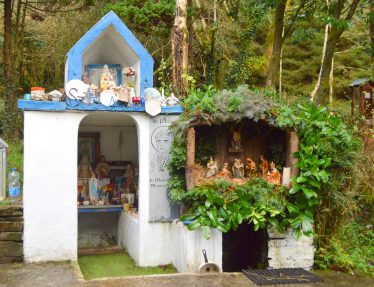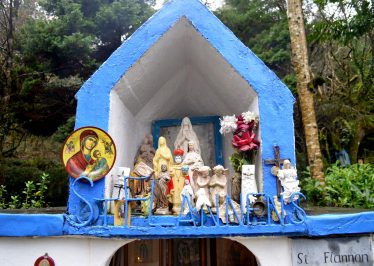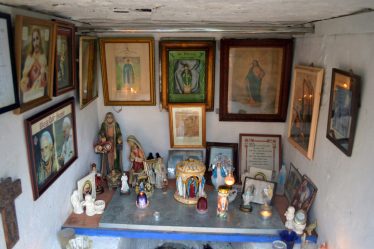Saint Flannan's Well, Tobar Fhlannáin, Drumanure









Townland: Drumanure, Inagh
Description of Holy Well and Landscape Setting
This holy well is part of a large site that includes a ’rounding’ path, with Stations of the Cross, homemade grottoes fashioned from a variety of everyday materials, and a shelter for rainy days. A large statue of the Blessed Virgin Mary, and a more recent statue of Saint Imy have been gifted to the site. There is a stone ‘bed’ in which pilgrims lie to receive help with backache. The holy well is contained in a small well house with numerous statues and religious objects. A second smaller well to the right provides the means of water collection for home. A footprint of the saint in stone is seen to the right of the well.
Saint and Feast Day Associated with Holy Well
The well is dedicated to Flannan, a 7th century saint. He was the son of Turlough, King of Thomond. In time, he became Abbot of Molua’s monastery in Killaloe and later on, a bishop. He is the patron of the Diocese of Killaloe and there is a church and oratory in his name there. His feast day is 18th December.
As well as helping with backache, the well is said to hold a cure for arthritis and headaches. The prayers sequence is outlined in the National Folklore Collection, Schools’ Collection, Toonagh School, Volume 0611, p173:
‘They perform rounds to these wells on two Sundays and a Thursday. If you performed a round to this well on the eighteenth of December you need not visit it any more.’
This holy well was championed by dedicated locals for many years.
Natural Heritage around the Holy Well
There are a large number of mature trees on the site including an important ash known as ‘the unusual tree’. This may be another instance of a sacred tree in Clare – or is at least a treasured companion tree to the well.
Heritage Attractions Nearby
The village of Inagh is approximately 10 minutes away. The well is situated just a little back from the road to Ennistymon and Corofin.
Additional Information
There is another holy well dedicated to Saint Flannan near Lahinch at Killaspuglonane. This townland name, Cill Easpaig Fhlannán means ‘The Church of Bishop Flannan’. Here, the saint is also known as Lonane.
A record in the Ordnance Survey Parish Namebook from 1839 reads:
‘There is a burial ground in this townland called Kiledrumanoor and a holy well called Tubberdrumanoor’
However, the 1842 Ordnance Survey map does not show the burial ground. There are cillíns, burial grounds on unconsecrated earth, in the neighbouring townlands of Gortbofarna and Garvoghil.
Discover More…
More about the Ordnance Survey Records, Royal Irish Academy
Record of Monuments and Places Number
RMP-CL024-024
Surveyed by Michael Houlihan




No Comments
Add a comment about this page